Magnus Carlsen “completes” chess as he bags World Cup title
by Carlos Alberto Colodro
8/24/2023
Praggnanandhaa vs. Carlsen - Rapid game #1
Black has an edge thanks to his more active pieces. More importantly, Carlsen had been putting pressure on Pragg for a while now, and the Indian had less than 20 seconds on the clock at this point — no wonder he erred with 42.a6 here.
There followed 42...bxa6 43.Ba4 Rc3 44.Na5
Going for the c6-pawn only distracted White’s pieces from defending his king. Carlsen played 44...Ng5 and 44...Ngh3+ on the next two moves, creating mating threats that Pragg could not counter without giving up a lot of material. Resignation came on move 4
The podium | Photo: FIDE / Stev Bonhage
by Carlos Alberto Colodro
8/24/2023
– Magnus Carlsen has won it all. The world number one beat Praggnanandhaa Rameshbabu in tiebreaks to win the FIDE World Cup for the first time in his career. After his victory, the Norwegian noted that he will not attempt to recover the World Championship title unless there is a major change in the format, especially regarding the shortening of time controls. Meanwhile, third seed Fabiano Caruana beat Nijat Abasov in the match for third place to secure a spot in the 2024 Candidates Tournament. | Photo: FIDE / Stev Bonhage
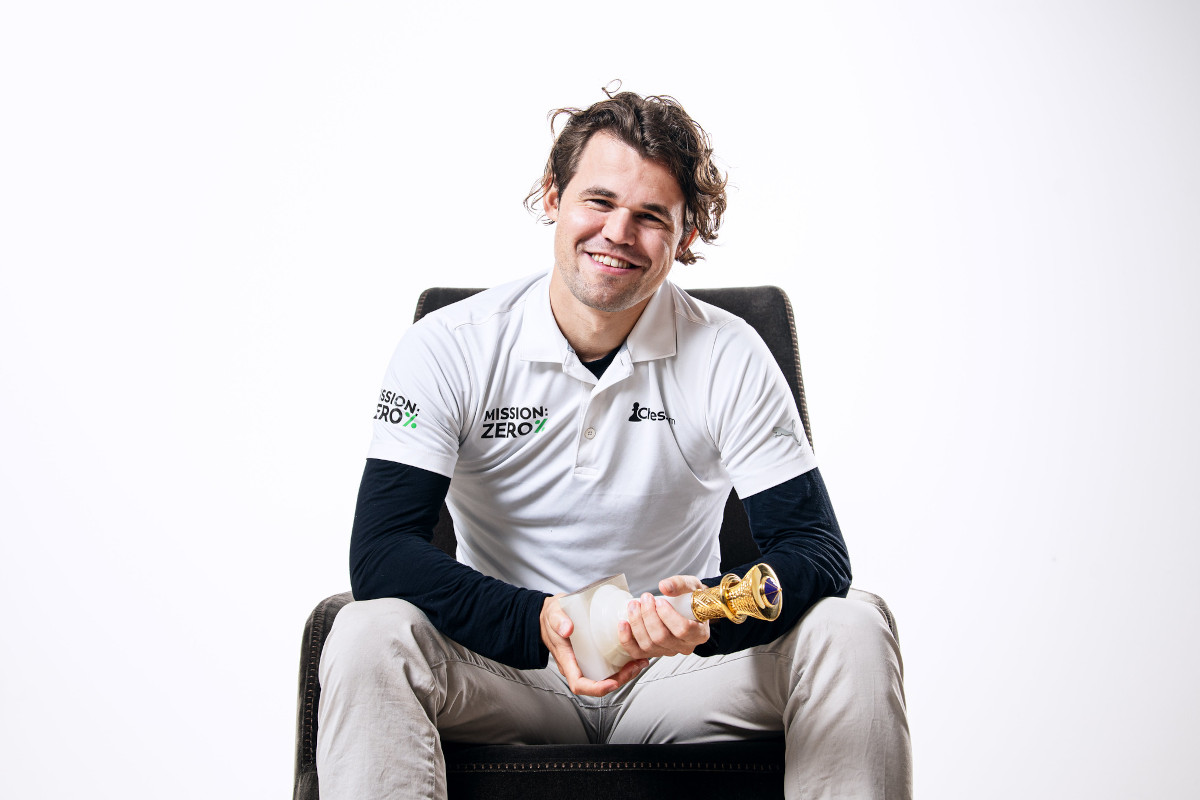
A clash of generations
There is no hiding the fact that a new generation of elite chess players is slowly taking over the sport. In the final of the FIDE World Cup, Magnus Carlsen, who was born in 1990 and obtained his GM title in 2004, defeated a player born in 2005 — the talented and ever-humble Praggnanandhaa Rameshbabu.
Also known as Pragg, the youngster from Chennai had a remarkable showing in Baku, as he knocked out both Hikaru Nakamura and Fabiano Caruana (seeded second and third respectively) before reaching the final against Carlsen. For his efforts, the prodigy gained 20.2 rating points in classical chess, thus climbing to the 20th spot in the live ratings list.
In this Fritztrainer: “Attack like a Super GM†with Gukesh we touch upon all aspects of his play, with special emphasis on how you can become a better attacking player.
Pragg also climbed to the 3rd spot among the juniors (under-20 players), as he now stands only behind Alireza Firouzja and Dommaraju Gukesh. The top-3 are joined by yet three more prodigies who have already crossed the 2700 rating barrier. Or as Carlsen put it in an interview conducted by the chess24 commentary team:
I think this generation of players born 1990-94 really have dominated for a long time, and finally now with these youngsters born 2003 and after, we have a generation that’s worthy of succeeding us when the time comes — the time could be fairly soon!
It will certainly be exciting for chess fans to see this story unfolding as time goes by. Will it be Firouzja who goes on to dominate? Or will it be one of the three Indians — Gukesh, Pragg and Arjun Erigaisi? Perhaps Nodirbek Abdusattorov, or the steady climber Vincent Keymer...
For now, however, the likes of Carlsen, Caruana, Nakamura and world champion Ding Liren are still going strong!
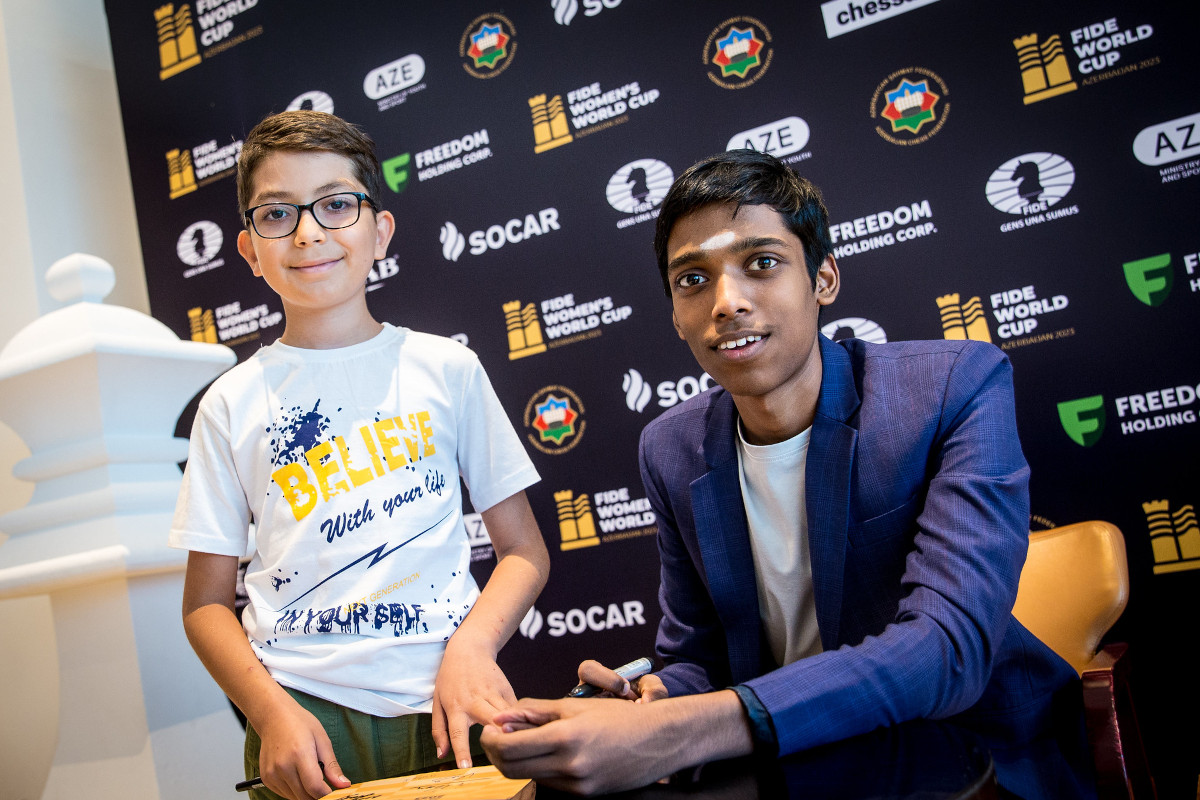
Praggnanandhaa signing autographs for even younger fans! |

A clash of generations
There is no hiding the fact that a new generation of elite chess players is slowly taking over the sport. In the final of the FIDE World Cup, Magnus Carlsen, who was born in 1990 and obtained his GM title in 2004, defeated a player born in 2005 — the talented and ever-humble Praggnanandhaa Rameshbabu.
Also known as Pragg, the youngster from Chennai had a remarkable showing in Baku, as he knocked out both Hikaru Nakamura and Fabiano Caruana (seeded second and third respectively) before reaching the final against Carlsen. For his efforts, the prodigy gained 20.2 rating points in classical chess, thus climbing to the 20th spot in the live ratings list.
In this Fritztrainer: “Attack like a Super GM†with Gukesh we touch upon all aspects of his play, with special emphasis on how you can become a better attacking player.
Pragg also climbed to the 3rd spot among the juniors (under-20 players), as he now stands only behind Alireza Firouzja and Dommaraju Gukesh. The top-3 are joined by yet three more prodigies who have already crossed the 2700 rating barrier. Or as Carlsen put it in an interview conducted by the chess24 commentary team:
I think this generation of players born 1990-94 really have dominated for a long time, and finally now with these youngsters born 2003 and after, we have a generation that’s worthy of succeeding us when the time comes — the time could be fairly soon!
It will certainly be exciting for chess fans to see this story unfolding as time goes by. Will it be Firouzja who goes on to dominate? Or will it be one of the three Indians — Gukesh, Pragg and Arjun Erigaisi? Perhaps Nodirbek Abdusattorov, or the steady climber Vincent Keymer...
For now, however, the likes of Carlsen, Caruana, Nakamura and world champion Ding Liren are still going strong!

Praggnanandhaa signing autographs for even younger fans! |
Photo: FIDE / Anna Shtourman
As for Carlsen’s accolades, there is little that can be said besides the list of trophies shared by Norwegian journalist Tarjei J. Svensen on X.
Carlsen later shared the following GIF on his X account — chess, completed
Of course, what most fans were wondering after this victory was whether Carlsen is planning to fight to regain the World Championship title by playing the Candidates. In line with previous comments on the subject, the Norwegian asserted:
The one non-negotiable point for me, if I ever were to play the World Championship again, is that there would have to be more games and shorter time controls. [...] With the classical time control, I think there is just no way.
If that is the case, Nijat Abasov will get an invitation to the 2024 Candidates Tournament, which already has Ian Nepomniachtchi, Praggnanandhaa and Caruana in the list of participants. The remaining contenders will be decided by rating, according to the FIDE Circuit ranking and in the FIDE Grand Swiss.
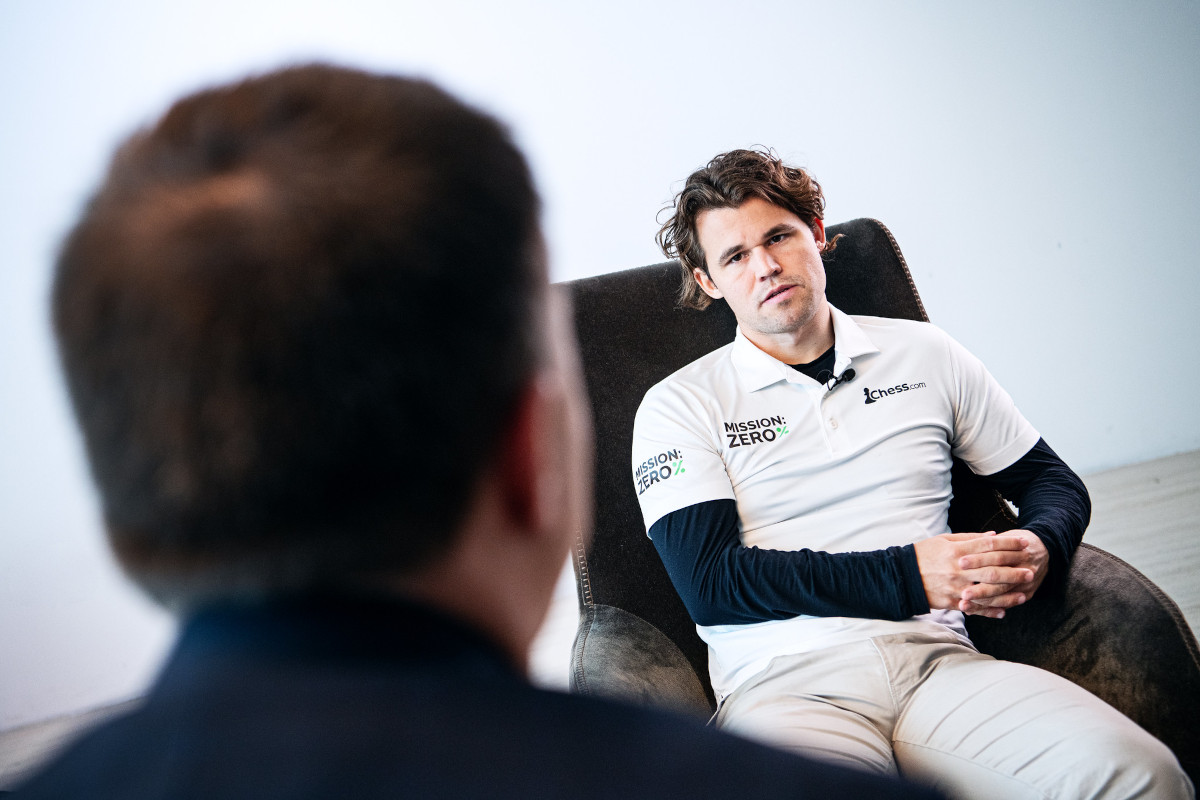
A man of strong opinions — Magnus Carlsen | Photo: FIDE / Stev Bonhage
In Thursday’s tiebreaks, Carlsen kicked off with a win. He had the black pieces and outplayed his young opponent in a queenless endgame.
As for Carlsen’s accolades, there is little that can be said besides the list of trophies shared by Norwegian journalist Tarjei J. Svensen on X.
The 32-year-old has won it all, as the World Cup was the one big trophy missing in his cabinet. Besides beating formidable opponents in five World Championship matches, Carlsen won the Rapid and Blitz Championships multiple times and has accumulated no fewer than eight triumphs at the traditional Tata Steel Masters in Wjik aan Zee.
Carlsen later shared the following GIF on his X account — chess, completed
Of course, what most fans were wondering after this victory was whether Carlsen is planning to fight to regain the World Championship title by playing the Candidates. In line with previous comments on the subject, the Norwegian asserted:
The one non-negotiable point for me, if I ever were to play the World Championship again, is that there would have to be more games and shorter time controls. [...] With the classical time control, I think there is just no way.
If that is the case, Nijat Abasov will get an invitation to the 2024 Candidates Tournament, which already has Ian Nepomniachtchi, Praggnanandhaa and Caruana in the list of participants. The remaining contenders will be decided by rating, according to the FIDE Circuit ranking and in the FIDE Grand Swiss.

A man of strong opinions — Magnus Carlsen | Photo: FIDE / Stev Bonhage
In Thursday’s tiebreaks, Carlsen kicked off with a win. He had the black pieces and outplayed his young opponent in a queenless endgame.
Praggnanandhaa vs. Carlsen - Rapid game #1
Black has an edge thanks to his more active pieces. More importantly, Carlsen had been putting pressure on Pragg for a while now, and the Indian had less than 20 seconds on the clock at this point — no wonder he erred with 42.a6 here.
There followed 42...bxa6 43.Ba4 Rc3 44.Na5
Going for the c6-pawn only distracted White’s pieces from defending his king. Carlsen played 44...Ng5 and 44...Ngh3+ on the next two moves, creating mating threats that Pragg could not counter without giving up a lot of material. Resignation came on move 4
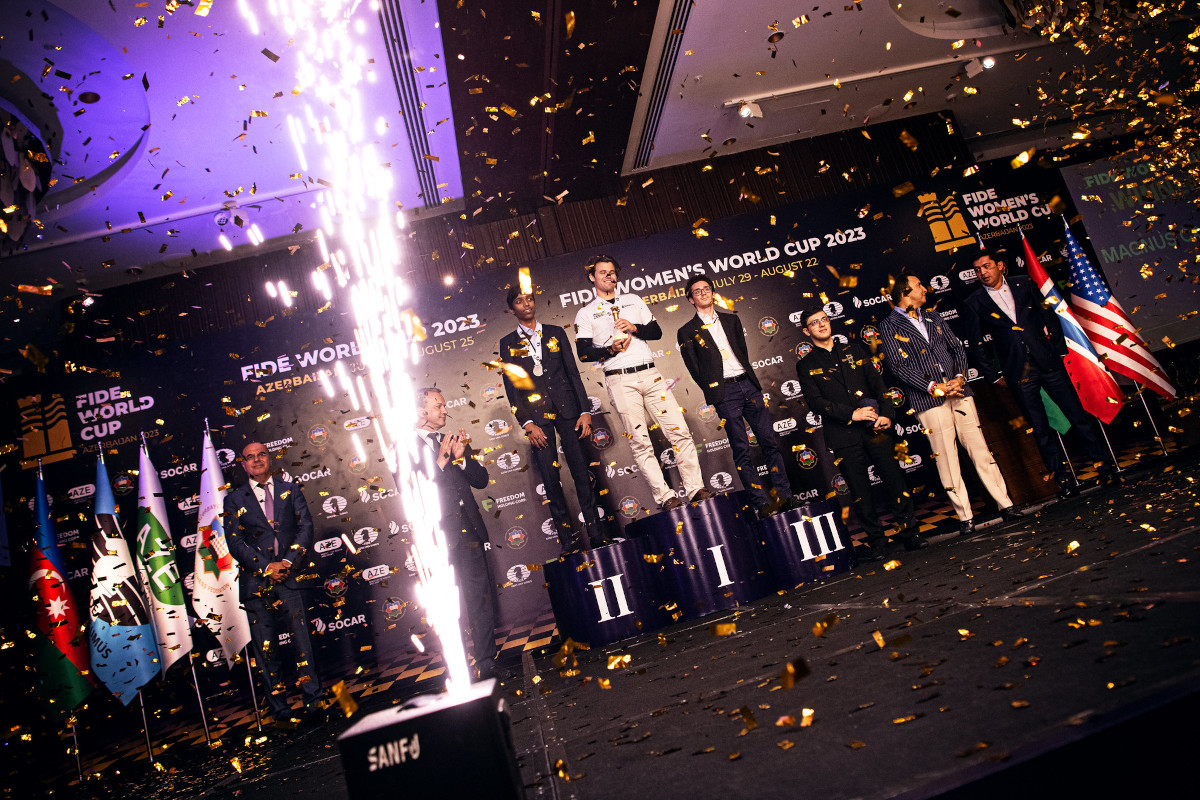 |
The podium | Photo: FIDE / Stev Bonhage
Norway’s world No 1 beat the 18-year-old 2.5-1.5 after playing cautiously in the first two games due to food poisoning
Leonard Barden
Fri 25 Aug 2023 08.00 BST
Magnus Carlsen has finally won the biennial World Cup, the only major individual honour to have eluded him. Norway’s World No 1 defeated India’s 18-year-old Rameshbabu Praggnanandhaa 2.5-1.5 in the final. Carlsen’s first prize was $110,000 and Praggnanandhaa’s $80,000.
Carlsen contracted food poisoning after his semi-final win last weekend and he was still recovering during the first two days of the final, where he played in an untypically cautious style, aiming for draws.
“I’ve been in pretty rough shape the last couple of days,” Carlsen said. “I got some food poisoning after the game against Abasov. I haven’t been able to eat for the last two days. This also meant that I was really calm because I had no energy to be nervous.”
In their second game, playing White, he even opened with an ancient version of the Four Knights 1 e4 e5 2 Nf3 Nc6 3 Nc3 Nf6 4 Bb5 Nd4 known to be highly drawish for over 100 years, to minimise risk. It was an obvious match strategy in the circumstances for Carlsen to aim for Thursday’s rapid and blitz tiebreaks, a genre where he is still the world champion and has vast experience.
The third game of the match, a 25-minute game with 10 seconds per move increment, virtually settled it. Praggnanandhaa had a small edge but burned up too much clock time and cracked at moves 42-44, after which he lost a bishop and resigned. Needing only half a point in game four, Carlsen swiftly simplified to a dead equal position.
Magnus Carlsen has finally won the biennial World Cup, the only major individual honour to have eluded him. Norway’s World No 1 defeated India’s 18-year-old Rameshbabu Praggnanandhaa 2.5-1.5 in the final. Carlsen’s first prize was $110,000 and Praggnanandhaa’s $80,000.
Carlsen contracted food poisoning after his semi-final win last weekend and he was still recovering during the first two days of the final, where he played in an untypically cautious style, aiming for draws.
“I’ve been in pretty rough shape the last couple of days,” Carlsen said. “I got some food poisoning after the game against Abasov. I haven’t been able to eat for the last two days. This also meant that I was really calm because I had no energy to be nervous.”
In their second game, playing White, he even opened with an ancient version of the Four Knights 1 e4 e5 2 Nf3 Nc6 3 Nc3 Nf6 4 Bb5 Nd4 known to be highly drawish for over 100 years, to minimise risk. It was an obvious match strategy in the circumstances for Carlsen to aim for Thursday’s rapid and blitz tiebreaks, a genre where he is still the world champion and has vast experience.
The third game of the match, a 25-minute game with 10 seconds per move increment, virtually settled it. Praggnanandhaa had a small edge but burned up too much clock time and cracked at moves 42-44, after which he lost a bishop and resigned. Needing only half a point in game four, Carlsen swiftly simplified to a dead equal position.
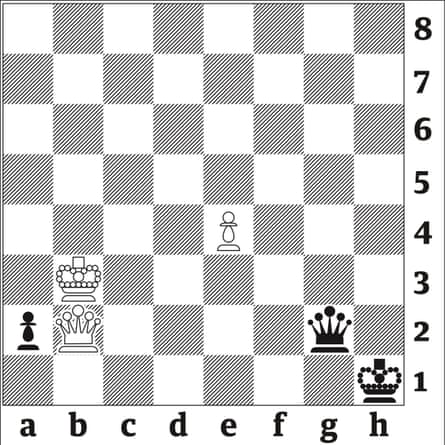
3882: Wang Hao v Boris Gelfand, Beijing 2013. Black to move and win. In the actual game, Gelfand overlooked the winning sequence and drew tamely by 1...Qxe4 2 Qxa2.
For Praggnanandhaa, this World Cup has still been a major success. He now qualifies for the 2024 Candidates, the eight-player tournament to decide the challenger to China’s Ding Liren. He is the third youngest Candidate ever, behind only Carlsen and Bobby Fischer. In the race among the rising young generation, he has gained ground against his rivals Alireza Firouzja, Dommaraju Gukesh and Nodirbek Abdusattorov.
The third place playoff was a triumph for the US champion and world No 2, Fabiano Caruana, who had been upset by Praggnanandhaa in the semi-finals. Caruana was still in shock in his first game against the hometown hero Nijat Abasov when 23...f5! would have been fine. Three moves later, he resigned in the face of 26...exf5 27 Nf6+! gxf6 28 Qxh6+! Kxh6 29 Rh3 mate.
Then Caruana fought back strongly, grinding out a difficult endgame win in game two, and winning the final two games by fine attacking for a 3-1 scoreline. Both players qualify for the 2024 Candidates.
The Women’s World Cup went to Russia’s No 2 seed, Alexandra Goryachkina, who defeated the surprise finalist, Nurgyul Salimova, by 1.5-0.5, after the Bulgarian failed to spot an easy drawing chance late in their marathon 105-move second game. Goryachkina narrowly missed the world crown in 2020 when she lost a title match to China’s Ju Wenjun by 7.5-8.5 after being ahead at one stage. For the future in women’s chess, there could be greater Western interest as two rising stars are Eline Roebers, 17, from the Netherlands and America’s Alice Lee, 13.
The Northumberland Masters, the premier chess event in the north, takes place at Newcastle this weekend, with opportunities for Fide title norms and a £600 bonus pool donated by Mark Jordan, a former English Chess Federation publicity manager. GMs Keith Arkell and Danny Gormally are among the top seeds. Play can be followed live and free on chess24.com.
Several English players have been campaigning for GM norms and titles this summer. Three norms and a 2500 rating are needed, which is proving a stiff task for Harry Grieve, 22, and Peter Roberson, 34 (two norms each), Matthew Wadsworth, 23, and Shreyas Royal, 14, (one each) and Jonah Willow, 20 (no norms yet but some near misses). Of these, Wadsworth and Willow are competing at Newcastle.
For Praggnanandhaa, this World Cup has still been a major success. He now qualifies for the 2024 Candidates, the eight-player tournament to decide the challenger to China’s Ding Liren. He is the third youngest Candidate ever, behind only Carlsen and Bobby Fischer. In the race among the rising young generation, he has gained ground against his rivals Alireza Firouzja, Dommaraju Gukesh and Nodirbek Abdusattorov.
The third place playoff was a triumph for the US champion and world No 2, Fabiano Caruana, who had been upset by Praggnanandhaa in the semi-finals. Caruana was still in shock in his first game against the hometown hero Nijat Abasov when 23...f5! would have been fine. Three moves later, he resigned in the face of 26...exf5 27 Nf6+! gxf6 28 Qxh6+! Kxh6 29 Rh3 mate.
Then Caruana fought back strongly, grinding out a difficult endgame win in game two, and winning the final two games by fine attacking for a 3-1 scoreline. Both players qualify for the 2024 Candidates.
The Women’s World Cup went to Russia’s No 2 seed, Alexandra Goryachkina, who defeated the surprise finalist, Nurgyul Salimova, by 1.5-0.5, after the Bulgarian failed to spot an easy drawing chance late in their marathon 105-move second game. Goryachkina narrowly missed the world crown in 2020 when she lost a title match to China’s Ju Wenjun by 7.5-8.5 after being ahead at one stage. For the future in women’s chess, there could be greater Western interest as two rising stars are Eline Roebers, 17, from the Netherlands and America’s Alice Lee, 13.
The Northumberland Masters, the premier chess event in the north, takes place at Newcastle this weekend, with opportunities for Fide title norms and a £600 bonus pool donated by Mark Jordan, a former English Chess Federation publicity manager. GMs Keith Arkell and Danny Gormally are among the top seeds. Play can be followed live and free on chess24.com.
Several English players have been campaigning for GM norms and titles this summer. Three norms and a 2500 rating are needed, which is proving a stiff task for Harry Grieve, 22, and Peter Roberson, 34 (two norms each), Matthew Wadsworth, 23, and Shreyas Royal, 14, (one each) and Jonah Willow, 20 (no norms yet but some near misses). Of these, Wadsworth and Willow are competing at Newcastle.
England’s likely next GM, however, is Ameet Ghasi. The 36-year-old, whose family is from Kashmir and whose twin brother, Sumeet, is also a strong player, was a youthful prodigy who won the British Rapidplay at only 13, still an age record. Then he decided to give priority to his studies, abandoned chess for a decade, took a biochemistry degree at Birmingham, and qualified as an accountant. Returning in 2011, he swiftly gained his IM title and has since further improved his rating, mainly via games in the national 4NCL league, to its current 2506. He already has two GM norms from Southend 2023 and Wood Green 2023, so just needs a third for the title.
Ghasi’s playing style used to be patient grinds from closed openings, perhaps influenced by Mir Sultan Khan, who came to the UK from what is now Pakistan in the late 1920s, reached the world top 10 and beat José Capablanca in a marathon at Hastings. Sultan also preferred slow openings from which he could outplay opponents in strategical middle games.
Ghasi has gradually evolved to a more universal style, and won this incisive attacking game at his latest tournament, the King Mohamed VI Open in Casablanca, Morocco, the venue for the chess scene in Humphrey Bogart’s famous film.
At halfway in Casablanca last week Ghasi had an unbeaten 3.5/5, including a fighting draw against Alexey Shirov, the former world title challenger, and was on course for his third GM norm, before fading to 5/9 against the uniformly high-class opposition. A near miss, and his time should soon come.
The 22-year-old British woman champion, Lan Yao, who at Leicester achieved her WGM title and missed an IM norm by only half a point, tries again on 2 September at First Saturday Budapest, the city where she scored her first WGM norm in 2017.
3882: 1...Qg8+! 2 Kc2 (if 2 Kb4 Qb8+ 3 Kc3 Qh8+ and 4...a1=Q+) Qc4+ 3 Kd2 Qf1! 4 Qh8+ (if 4 Qxa2 Qf2+ and Qxa2) Kg1! wins after 5 Qg7+ Qg2+ or 5 Qd4+ Qf2+.
No comments:
Post a Comment